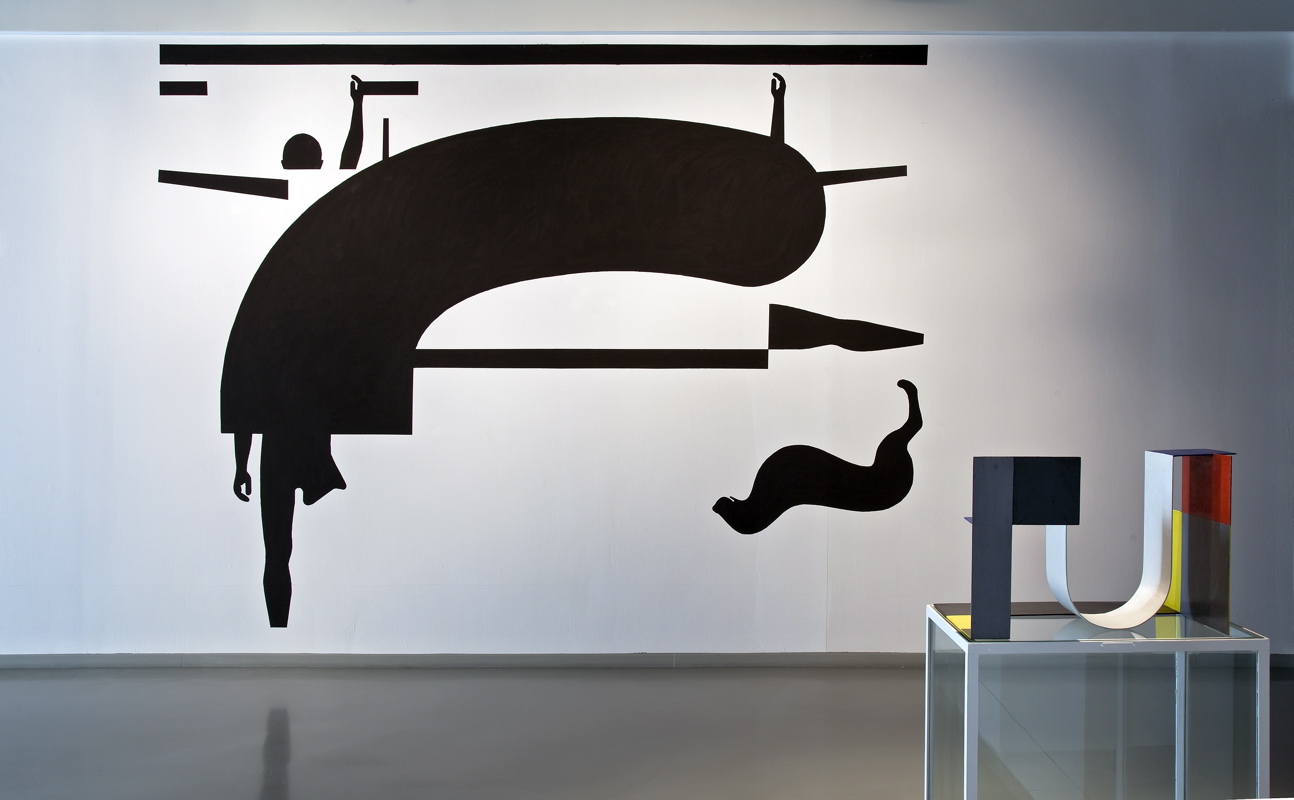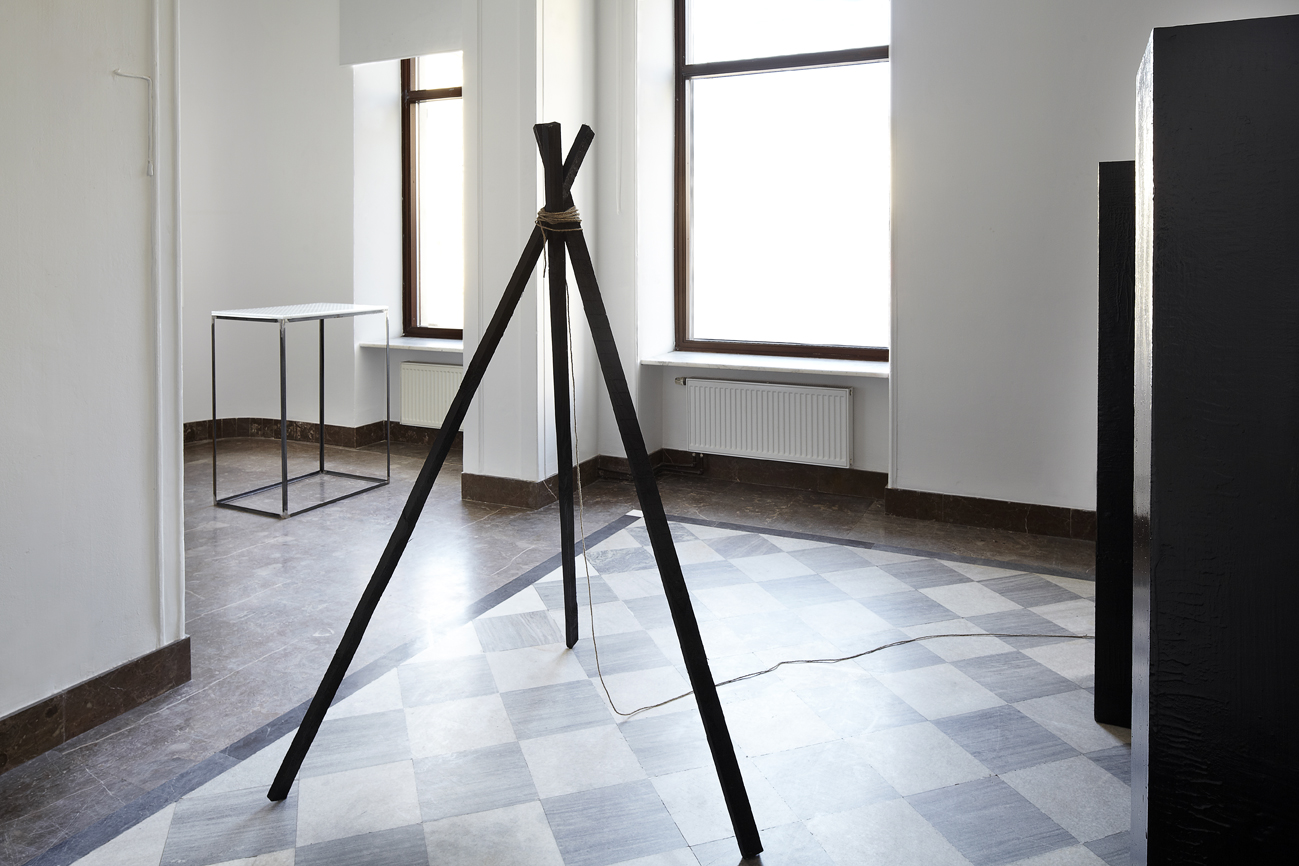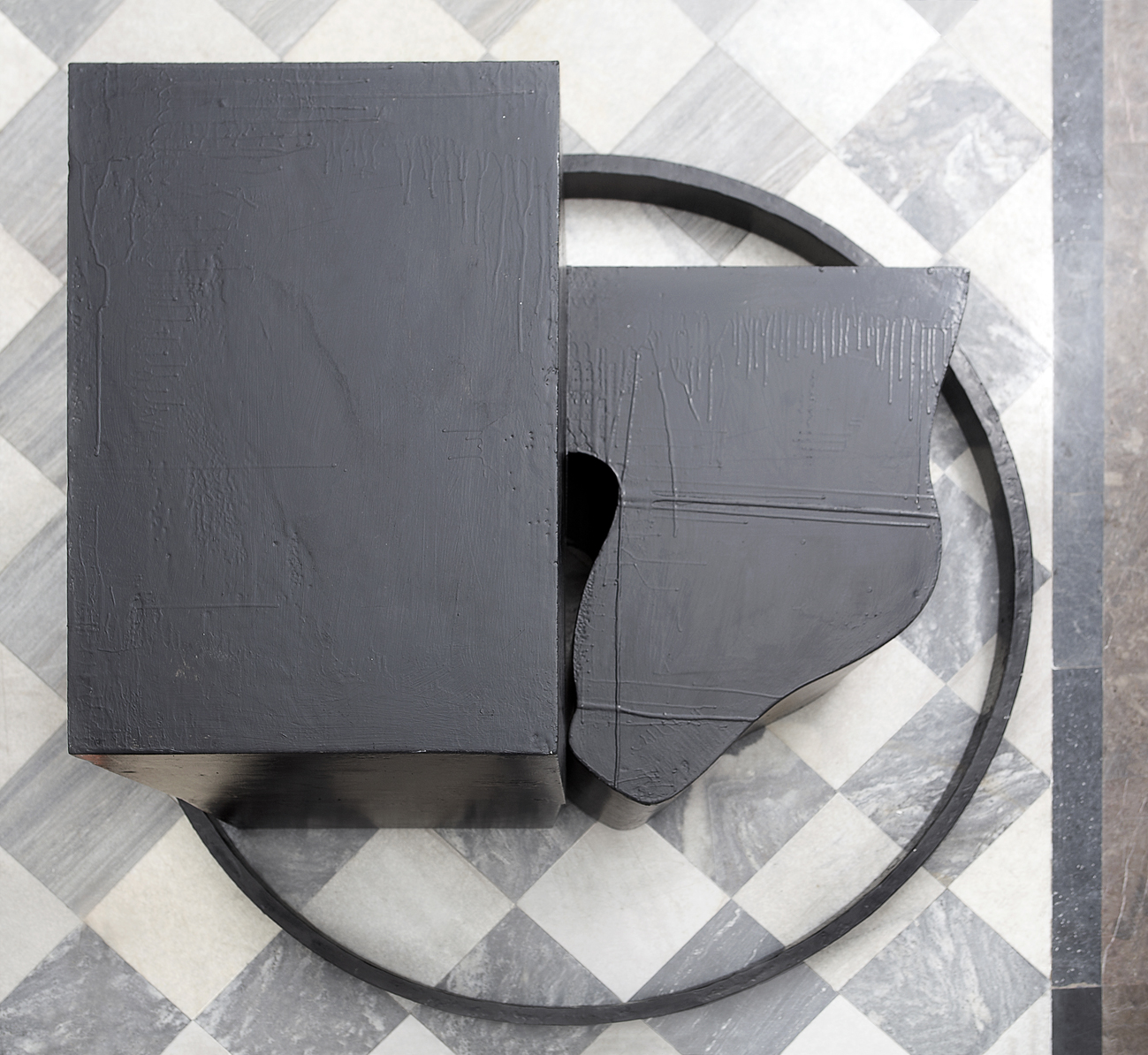Monika Zawadzki at Kordegarda Gallery
Monika Zawadzki Tent and the Fireplace at Kordegarda Gallery, Warsaw, October 11– November 4, 2012
 When viewers entered the gallery where the exhibition of Monika Zawadzki was installed they were confronted by a tent and fireplace, both of them easily associated with the living areas of the first societies. In this way Zawadzki, whose work was also presented in the exhibition The Biggest Delight is To Avoid Contact with Society, in Warsaw (2006), creates a situation that refers to the rituals of community creation.
When viewers entered the gallery where the exhibition of Monika Zawadzki was installed they were confronted by a tent and fireplace, both of them easily associated with the living areas of the first societies. In this way Zawadzki, whose work was also presented in the exhibition The Biggest Delight is To Avoid Contact with Society, in Warsaw (2006), creates a situation that refers to the rituals of community creation.
Zawadzki recalls the archaic and the archetypical, bringing us closer to the questions about building the first communities and modern civilization: where did we come from? How were our societies and the rules governingthem shaped? Where do architecture, the law, and our social institutions come from? How are relationships between individuals constructed?
Zawidzki uses the moment when the problem of participation and supporting local communities is one of the most significant – and maybe even fashionable – strategies for contemporary art. It’s a logical consequence of the processes that began in the 1960s when the revolution in social life resulted in a new approach to art’s objectives, and the political dimension of every single activity was discovered. In today’s crisis, at a time when we are looking for a new kind of community, the problem of the connection between “art and politics” has acquired new importance for art institutions, curators and artists. A manifestation of this was the last Berlin Biennale curated by artist Artur ?mijewski. However, interestingly, Zawadzki does not follow this path. In her installation she uses a pure language of art based on basic forms.
 Form is the starting point, as the artist has stated many times, it is not a goal in itself. An important component of Zawadzki’s emerging forms is their impact on the viewer’s consciousness. The “forms-characters-symbols” language, so characteristic of Zawadzki, was first developed while the artist was working on the graphic cycle Human and Animals Rights in 2008. Today she continues to work with the forms that were generated at that time; overworking and expanding them. Zawadzki examines new relationships between them, updating the spectrum of their meanings. Zawadzki’s language is usually limited to the contrasts of black and white. The silhouettes of both people and animals bear simplified forms that show the similarities between all beings and equate them with each other. Sometimes their forms are mixed, which creates a kind of combined identity for these beings: female, male, dog, or cow, all have in their DNA an element of monumentality, and the strength of these forms is similar to those created? worked by the Constructivists.
Form is the starting point, as the artist has stated many times, it is not a goal in itself. An important component of Zawadzki’s emerging forms is their impact on the viewer’s consciousness. The “forms-characters-symbols” language, so characteristic of Zawadzki, was first developed while the artist was working on the graphic cycle Human and Animals Rights in 2008. Today she continues to work with the forms that were generated at that time; overworking and expanding them. Zawadzki examines new relationships between them, updating the spectrum of their meanings. Zawadzki’s language is usually limited to the contrasts of black and white. The silhouettes of both people and animals bear simplified forms that show the similarities between all beings and equate them with each other. Sometimes their forms are mixed, which creates a kind of combined identity for these beings: female, male, dog, or cow, all have in their DNA an element of monumentality, and the strength of these forms is similar to those created? worked by the Constructivists.
 With Zawadzki’s works, there is always also a reference to an idea. With one of her “redesigned” creatures she is able to speak of difficult emotions, oppression, isolation, pain, violence, physical limitations, and ambitions. Via graphical language – but not slipping into narration – the artist raises topics such as racism, homophobia, feminism and vegetarianism. As an Art Director, Zawadzki has also worked for Karol Radziszewski’s DIK FAGAZINE, the first magazine in Eastern Europe devoted to homosexuality. On the occasion of the exhibition Anyone in Warsaw, Zawadzki first transferred this graphic language to the natural space, creating multidimensional objects. However, despite this change from graphics to art, the most important features of Zawadzk’s language have not changed. The artist always highlights the fact that she does not sculpt her objects, she designs them.
With Zawadzki’s works, there is always also a reference to an idea. With one of her “redesigned” creatures she is able to speak of difficult emotions, oppression, isolation, pain, violence, physical limitations, and ambitions. Via graphical language – but not slipping into narration – the artist raises topics such as racism, homophobia, feminism and vegetarianism. As an Art Director, Zawadzki has also worked for Karol Radziszewski’s DIK FAGAZINE, the first magazine in Eastern Europe devoted to homosexuality. On the occasion of the exhibition Anyone in Warsaw, Zawadzki first transferred this graphic language to the natural space, creating multidimensional objects. However, despite this change from graphics to art, the most important features of Zawadzk’s language have not changed. The artist always highlights the fact that she does not sculpt her objects, she designs them.
Zawadzki’s iconic language is also palpable in the show The Tent and Fireplace, curated by Marta Czy?. The tent is built of three high boards, painted black and tied together with a string in the form ofa pyramid. The campfire, made from raw pieces of wood, is also painted black, and repeats the same shape on a smaller scale. However, despite the fact that the two objects belong to each other, and are even linked with a piece of twine lying on the floor, there is an element paradoxically called “Connector”—a block of black elements made of polyurethane—standing between them. Moreover, this is the most enigmatic object on display. The Connector divides the gallery space more or less in half, and it became a kind of blind center of the exhibition, with the other elements situated around it. Because of this, the story that the tent and the campfire tell in Zawadzki’s installation is not the story of the warmth of a household fireplace, but a story of longing and separation. At the same time, the connection between the two objects still works, and the relationship between them is not allowed to be broken. In an interview printed in a publication that accompanies the show, Zawadzki remarked that these two forms are to be understood as a family.
 In other works, the artist asks the question if and where animals fit into our community. Circle Cow’s Head Two Cubes is a geometric, fragmentized form closed in an ideal circle. Among other forms, it appears to contain the severed head of a cow, as in a sacrifice. The cow’s rounded snout calls for our compassion and asks why as a society we still eat meat. Symptomatic? Important? for the perception? Understanding? of the role of animals in Western civilization from antiquity to today is the monument of Prince Józef Poniatowski on a horse next to the entrance of Kordegarda Gallery. The rider illustrates the subservient role assigned to animals in our culture, as if the neighborhood created an unexpected context for the exhibition, and for Zawadzki’s philosophy and her call for a change of attitude.
In other works, the artist asks the question if and where animals fit into our community. Circle Cow’s Head Two Cubes is a geometric, fragmentized form closed in an ideal circle. Among other forms, it appears to contain the severed head of a cow, as in a sacrifice. The cow’s rounded snout calls for our compassion and asks why as a society we still eat meat. Symptomatic? Important? for the perception? Understanding? of the role of animals in Western civilization from antiquity to today is the monument of Prince Józef Poniatowski on a horse next to the entrance of Kordegarda Gallery. The rider illustrates the subservient role assigned to animals in our culture, as if the neighborhood created an unexpected context for the exhibition, and for Zawadzki’s philosophy and her call for a change of attitude.
The gallery was “furnished” with one more sculpture, this one entitled Wet Table. It featured a transparent plastic top. Between the two layers of the sculpture white and creamy milk oozed out of many little holes. As the milk changed consistency and structure over time, its scent also changed from being pleasant to unpleasant. In this state, the milk elicits discomfort rather than the nostalgia of childhood. For Zawadzki, who likes clear forms, the use of milk is a bit like acting against herself, opening herself up to the transformations of form. The materials Zawadzki uses often take us closer to the roots of civilization: not only polyurethane (painted black), so characteristic of her work, but also rough wood, hemp cord, and organic milk. The artist wants us to deal with something primal that makes us think about those things that do not change even in the face of developing civilization. Zawadzki wants these materials to play the role of a doorway that makes the viewer a part of the community. The materials establish an emotional relationship with the viewer, they awaken his or her attention and memories of a first touch or a first smell.
 However, there are other materials that seem fundamental to the exhibition and its contemporary dimension. Zawadzki uses transparent plastic as a contrast to the natural materials. Plastic is nothing new to Zawadzki’s art; in the work Discomfort (2011), she used transparent cubes to encase the head and feet of the viewers, forcing them to take an uncomfortable position. One of Zawadzki’s latest sculptures, Mud, explores the importance of plastic for modern times, and includes a plastic box with hand-shaped holes. Could it be that plastic is a kind of second skin that does not allow one to get dirty, and also prevents you from any open and direct contact with the outside world?
However, there are other materials that seem fundamental to the exhibition and its contemporary dimension. Zawadzki uses transparent plastic as a contrast to the natural materials. Plastic is nothing new to Zawadzki’s art; in the work Discomfort (2011), she used transparent cubes to encase the head and feet of the viewers, forcing them to take an uncomfortable position. One of Zawadzki’s latest sculptures, Mud, explores the importance of plastic for modern times, and includes a plastic box with hand-shaped holes. Could it be that plastic is a kind of second skin that does not allow one to get dirty, and also prevents you from any open and direct contact with the outside world?
The exhibition at Kordegarda, dedicated as it was to constructing a community, was more than just a simple illustration of the need for community; it was a presentation of the benefits of participation, an optimistic encouragement to do work with one’s neighbors. Zawadzki tells a story of the impossibility of fulfillment, of longing for man and freedom, of the beauty of a warm fireplace, of relationships that build a family. She also speaks to the need for emancipation. In short, she addresses our search for comfort as much as the way we feel trapped by it once we attain it. The artist does not build utopia, but shows the moments that prevent us from building the perfect community, that cause permanent, and creative, tensions. The tent and the campfire remain symbols of longing; they still represent? the direction to our thoughts and our bodies.



